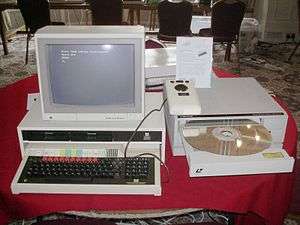Digital obsolescence

Digital obsolescence is a situation where a digital resource is no longer readable because of its archaic format: the physical media, the reader (required to read the media), the hardware, or the software that runs on it is no longer available.[1]
A prime example of this is the BBC Domesday Project from the 1980s, although its data was eventually recovered after a significant amount of effort. Cornell University Library’s digital preservation tutorial (now hosted by ICPSR) has a timeline of obsolete media formats, called the “Chamber of Horrors”, that shows how rapidly new technologies are created and cast aside.
Introduction
The rapid evolution and proliferation of different kinds of computer hardware, modes of digital encoding, operating systems and general or specialized software ensures that digital obsolescence will become a problem in the future.[2] Many versions of word-processing programs, data-storage media, standards for encoding images and films are considered "standards" for some time, but in the end are always replaced by new versions of the software or completely new hardware. Files meant to be read or edited with a certain program (for example Microsoft Word) will be unreadable in other programs, and as operating systems and hardware move on, even old versions of programs developed by the same company become impossible to use on the new platform (for instance, older versions of Microsoft Works, before Works 4.5, cannot be run under Windows 2000 or later).
Early attention was brought to the challenges of preserving machine-readable data by the work of Charles M Dollar in the 1970s, but it was only during the 1990s that libraries and archives came to appreciate the significance of the problem[3] and has been discussed among professionals in those branches, though so far without any obvious solutions other than continual forward-migration of files and information to the latest data-storage standards. File formats should be widespread, backward compatible, often upgraded, and, ideally, open format. The National Initiative for a Networked Cultural Heritage cites[4] the following as “de facto” formats that are unlikely to be rendered obsolete in the near future: uncompressed TIFF and ASCII and RTF (for text).
In order to prevent this from happening, it is important that an institution regularly evaluate and explore its current technologies and evaluate its long term business model.[5]
Types
Digital objects are vulnerable to three types of obsolescence:[6]
- Physical media: the physical carrier of the digital file becomes obsolete; e.g. 8 inch floppy disks, which are no longer commercially available.
- Hardware: the hardware needed to access the digital file becomes obsolete; e.g. floppy disk drive, which computers are no longer manufactured with.
- Software: the software needed to access the digital file becomes obsolete; e.g. WordStar, a word processor popular in the 1980s which used a closed data format and is no longer readily available.
Strategies
Any organization that has digital records should assess its records to identify any potential risks for file format obsolescence. The Library of Congress maintains Sustainability of Digital Formats, which includes technical details about many different format types. The UK National Archives maintains an online registry of file formats called PRONOM.
In its 2014 agenda, the National Digital Stewardship Alliance recommended developing File Format Action Plans: "it is important to shift from more abstract considerations about file format obsolescence to develop actionable strategies for monitoring and mining information about the heterogeneous digital files the organizations are managing."[7]
File Format Action Plans are documents internal to an organization which list the type of digital files in its holdings and assess what actions should be taken to ensure its ongoing accessibility.[8] Examples include the Florida Digital Archive Action Plan and University of Michigan's Deep Blue Preservation and Format Support Policy.
Copyright issues
Untangling copyright issues also presented a significant challenge for projects attempting to overcome the obsolescence issues related to the BBC Domesday Project. In addition to copyright surrounding the many contributions made by the estimated 1 million people who took part in the project, there are also copyright issues that relate to the technologies employed. It is likely that the Domesday Project will not be completely free of copyright restrictions until at least 2090, unless copyright laws are revised for earlier expiration of software into public domain.[9]
Intentional obsolescence
In some cases, obsolete technologies are used in a deliberate attempt to avoid data intrusion in a strategy known as "security through obsolescence".[10]
See also
References
- ↑ "Managing Digital Obsolescence Risks" (pdf). The National Archives. April 2009.
- ↑ Rothenberg, J. (1998). Avoiding Technological Quicksand: Finding a Viable Technical Foundation for Digital Preservation
- ↑ Hedstrom, M. (1995). Digital Preservation: A Time Bomb for Digital Libraries
- ↑ National Initiative for a Networked Cultural Heritage. (2002). NINCH Guide to Good Practice in the Digital Representation and Management of Cultural Heritage Materials
- ↑ "Managing Digital Obsolescence Risks: Guidance for SIROS" (PDF). The National Archives. April 2009.
- ↑ "Obsolescence – a key challenge in the digital age". National Archives of Australia. Retrieved 17 March 2014.
- ↑ "National Agenda for Digital Stewardship 2014" (PDF). National Digital Stewardship Alliance. 2014. Retrieved 17 March 2014.
- ↑ Owens, Trevor (6 January 2014). "File Format Action Plans in Theory and Practice". Retrieved 17 March 2014.
- ↑ Charlesworth, Andrew (5 November 2002). "The CAMiLEON Project: Legal issues arising from the work aiming to preserve elements of the interactive multimedia work entitled "The BBC Domesday Project."" (Microsoft Word). Kingston upon Hull: Information Law and Technology Unit, University of Hull. Retrieved 23 March 2011.
- ↑ Miller, Robin (2002-06-06). "Security through obsolescence". Linux.com. Retrieved 2008-07-18.
External links
- The Library of Congress, Sustainability of Digital Formats
- Wired Magazine: What death can't destroy and how to digitize it
- Digital Preservation at ICPSR